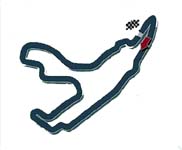| |
|
|
Jum'at - 31/8
Latihan Bebas 1
Latihan Bebas 2 |
Sabtu - 1/9
Latihan Bebas 1
Latihan Bebas 2
Kualifikasi |
Minggu - 2/9
Pemanasan
Balapan |
Circuit information:
| Round Number: |
14 |
|
| Race Date: |
02-09-2001 |
|
| Country: |
Belgium |
|
| City: |
Spa
(click for location
map) |
|
| Circuit Name: |
Spa-Franchorchamps |
|
| Circuit Length: |
6968 m. |
|
| Number of Laps: |
44 |
|
| Race Length: |
306.592 m |
|
| 2000 Pole Position: |
Mika Häkkinen |
|
| 2000 Winner: |
Mika Häkkinen |
|
| 2000 Fastest Lap: |
Rubens Barrichello |
|

|
SIRKUIT LELAKI SEJATI |
|
Belum
dianggap lelaki sejati sebelum berhasil
menaklukkan Spa-Francorchamps. Kenapa? Selain
terpanjang dan terlengkap karakter tikungannya,
Spa juga memberi siksaan bagi pembalap.
Heinzt-Harald
Frentzen, andalan tim Jordan mengaku,
"Settingnya susah setengah mati, dan kita
harus menahan gaya sampai 5G". Belum sempat
menarik napas selepas garis start, mobil harus
direm habis-habisan dari kecepatan 270 km/jam
sampai cuma 60 km/jam untuk menyikat La Source
Hairpin.
Memang
hairpin itu tikungan terpatah disini.
Tapi handycap selanjutnya tak kalah mengerikan.
Eau Rouge yang berkontur seperti ular itu, harus
dilibas 270 km/jam. Padahal, karakternya blind
corner, alias tidak bisa melihat tikungan di
depan. "Dibutuhkan insting dan feeling
buat belokan ini", anjur Michael Schumacher
yang 4 kali tabrakan di sirkuit sini.
Straight
bernama Kammel disikat 320 km.jam, dan di
ujungnya ada chicane Malmedy. Eh, cuma
200 meter di depan, ketemu hairpin lagi,
Rivage. Di sinilah Mika Hakkinen melakukan aksi
spektakuler menyusul Michael Schumacher -
sekaligus Ricardo Zonta - tahun lalu.
Tikungan
Pouhon yang setelahnya, relatif gampang dan
lebar. Bisa 250 km/jam sebelum kemudian masuk
Fagnes dan Stavelot. Karakternya nanggung dan
membuat dilema tersendiri. Terlalu cepat
melintir, terlalu pelan bisa tersusul.
Unik
adalah Bus Stop Chicane. Selain bentuknya yang
mirip halte bus, di pinggir jalan terbentang
tembok yang menanti pembalap melakukan
kesalahan. Secara umum, sirkuit 6,987 km ini
tergolong indah lantaran konturnya yang
berbukit.

|
|
Circuit
Description, History, Facts and
Figures
|
The Belgians have always been mad about motors
in any shape or form. It is this eclectic
attitude to the sport and diversity of interest,
which includes everything from Moto-X to
Rallying to Sports Cars and Formula 1, that goes
a long way to explaining why Grand Prix stardom
has pretty much evaded Europe's most densely
populated nation. Then again, with the delights
of the Spa- Francorchamps circuit on their
doorstep, perhaps the locals simply preferred to
switch disciplines and race there every week.
Belgium's most successful grand prix driver to
date is Jacky Ickx. The son of a motoring
journalist, he first made his name in motorcycle
trials and by the age of 22, he was competing in
Formula 1. The world championship seemed like a
formality, such was his composure, car control
and speed, especially in the wet. While rain did
indeed provide the backdrop to the most
memorable of his eight wins, his championship
potential was never quite realised, although he
did finish as runner-up in 1969 and 1970.
He is best remembered as one of the greatest
sports car drivers of all time, winning the Le
Mans 24 Hours on six occasions. In so doing, he
continued something of a Belgian tradition in
the French classic. Former World War II
paratrooper, Olivier Gendebien, like Ickx a
Ferrari grand prix driver, won Le Mans four
times. In 1960, he was partnered by another
fellow countryman, Paul Frere, who combined
racing with a successful career as a respected
motoring journalist.
Although none of the twenty or so Belgians on
the F1 roll-call has ever laid claim to the
World Championship, the country can boast the
most beautiful race track on the planet at
Spa-Francorchamps. Belgium was one of the seven
rounds of the inaugural Formula 1 World
Championship back in 1950. Spa has hosted more
grands prix than any other circuit except Monza,
providing a spectacular setting for the Belgian
round on 35 occasions including this year's
event. Among the many great ones, the 1966 race
stands out as a seminal moment. A young Jackie
Stewart was seriously injured after crashing his
BRM in the rainy conditions. The experience
sparked off his life-long campaign to increase
safety in the sport, the positive effects of
which are still with us today.
The original Spa-Francorchamps track was around
14 kilometres in length, made up of public
roads. Eventually, the speeds of the modern
grand prix car meant it was too dangerous to
race on and for 1971 the grand prix was switched
to Nivelles and the following year it found a
regular home at Zolder. When the event returned
to Spa in 1983, it was to a much reduced track
length, although it is still the longest one on
the GP calendar. The King of Spa is Ayrton
Senna, who won here five times, four of them
consecutively. Jim Clark has four Belgian
victories to his name, all of them consecutively
and all of them on the old circuit. Of the
current generation, Michael Schumacher also has
four wins to his credit, including his first
ever F1 win in 1992. He was also disqualified
for a technical infringement after crossing the
line first in 1994.
Formula One made two trips to Spa in 1985. With
a reputation for wet weather, this year a freak
heatwave hit the area in June when the Belgian
Grand Prix should have been held. The track
surface could not cope with the heat and the
race had to be rescheduled for September. |
|
|
|
|
|

|
|
Sirkuit - 2001 |
|
| |




















